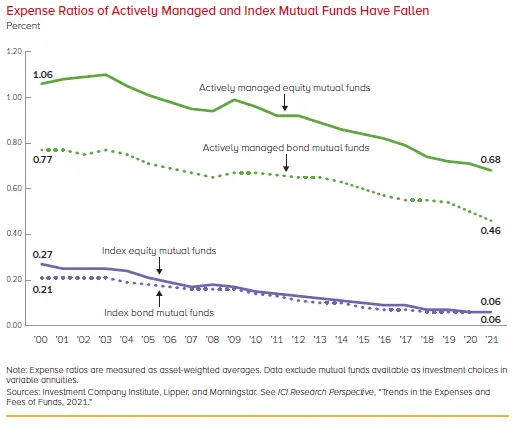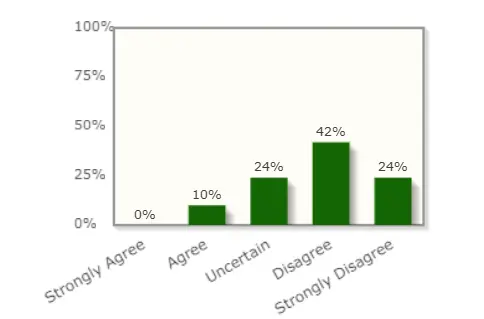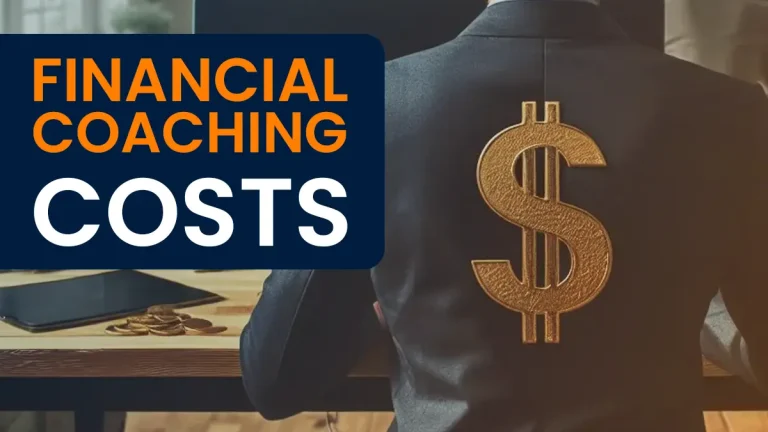What is a passive investing bubble?
A passive investing bubble refers to the inflated price of stocks due to high levels of passive investment into index funds, distorting the true market value.
As money flows into the index funds, the funds invest this money ‘indiscriminately’ into the companies in said index (weighted by current size). The share price of these companies rises. This then attracts more investment into index funds due to the strong performance, and the share price of the companies inside the fund continues to rise.
It is a ‘bubble’ as the price of a stock grows for a reason not related to its underlying performance, and ‘pops’ as the market crashes.
>> Read more: Is Passive Investing a Giant Ponzi Scheme? <<
Why might there be a passive investing (index funds) bubble in 2024?
Low fees
Index funds and ETFs are available at record-low fees. There are even loss-leading zero-fee funds from Fidelity available.
Fees – even small fractions of a percentage – eat heavily into your investment returns. The low expense ratios of passively managed index funds make them an extremely attractive medium for investing in equities.
Below, you can see their affordability versus actively managed funds:

Interestingly, the prices of both are coming down as investors seek increasingly lower-cost funds. Investors are wising up to the burden of fees, part of the reason for the boom in passive index funds. As a result, investment companies must become more price competitive in both the active and passive spheres.
Simplicity for new investors
Another reason for the supposed bubble is that index fund investing is simple. It is an accessible investment vehicle that is relatively easy to understand and set up, making it appealing for new investors looking to ‘get in the game’. These are the same newbie investors who might panic sell at the worst time.
Diversification and historical performance
Passive investing into index funds has had strong historical performance (which is never a guarantee of future results, but is reassuring). It offers fantastic diversification, which can mitigate risk. These are two big green flags for the sensible investor.
Fund providers are obliged to buy
As mentioned above, the large fund providers (Vanguard, Fidelity, BlackRock) happily take the new funds and ‘indiscriminately’ invest it into the companies in the index. They do not pause to look at the amount going into these funds. They do not look at P/E ratios or other performance indicators. They do as instructed; ‘blindly’ invest the new funds into the top few thousand companies in the world. They must not in any way ‘actively manage’.
The very top companies in the popular indexes – currently technology stocks – receive even more investment, fueled by this self-fulling passive investing cycle. Performance indicators scream that many companies in the index are extremely overvalued, but the price keeps on rising. This creates a passive investment bubble.
All these factors result in money flowing exponentially into passive index funds.
A Passive investment ‘bubble’ reduces market efficiency
The passive investment boom means that the market could become less efficient.
Firstly, this is because price discovery might be affected. That is, the market’s ability to efficiently incorporate information into prices. If a stock is being bought solely because it is included in a popular index, as opposed to the careful analysis of an active manager, that could distort true pricing.
The way the stock market works traditionally is that good companies rise to the top and bad companies fall away as active investors move money from bad companies into good companies.
As J.L. Collins puts it, the market is self-cleansing in this way.
As of 2018, none of the original 12 companies in the Dow Jones are still in there, with General Electric being the final company to be booted. New companies rise to replace those that are dead and dying. The market cleanses itself.
Index fund investors benefit from this built-in market efficiency, but it is active investors that enable the market efficiency.
If active investment did not exist, the self-cleansing market would not either. That’s because money would continually to be given to companies that are underperforming when they should be given to the next rising star.
As long as active investors are putting their money into the rising stocks based on careful analysis of those companies, the weighted passive-investment will be correctly assigned to the correct stocks.
If active investment is in the minority position, or active investors are investing in stocks purely because they are in a popular index, money is potentially flowing into the wrong stocks. This could cause a bubble.
So, the result of passive investment growing in popularity could make active investment and market efficiency decline.
Expert Poll: Academics weigh in on the bubble & market efficiency
A poll by The Initiative on Global Markets in November 2022 put the question of falling market efficiency to 40 academics. Participants were asked to state whether they agree or disagree with the following statement:
“The amount of passively invested funds has reached levels at which it has a measurable detrimental effect on market efficiency.”
When weighted by their confidence level, two thirds of participants disagreed with the statement. 24% were uncertain, and only 10% agreed with the statement.

John Cochrane, former president of the American Finance Association was one of those who strongly disagrees, commenting:
“Index funds largely expand investing to a population that didn’t hold stocks. Hedge funds have expanded. Not much evidence that there is less overall informed money, or that markets have become less efficient over time.”
In contrast, Campbell R. Harvey, another former president of the AFA, agreed with the statement. Quoting a 2018 paper from the Journal of Finance he adds:
“Researchers have looked at the impact on individual stocks when included in ETFs (passive). Evidence suggests that after inclusion volatility increases and there is also negative autocorrelation (JF 2018-link). These findings are consistent with a negative impact on efficiency.”
Though the majority disagreed with the statement, there is clearly not enough consensus to discard the possibility of a passive investing bubble distorting the markets.
How big is the passive investing bubble?
One of the key problems in identifying a passive investing bubble is that we don’t really know exactly how much of the market is passive investment. Estimates vary widely.
The most common assertion is that it is about 15-16%. Large, but still by no means dominant.
However, according to research from Harvard Business School in October 2022, 37.8% percent of the entire investment market is now passive investment. This is markedly above previous estimates.
The ICI (2022) also charts a steep rise in index fund investment over the last decade:

Morningstar maps a rise in passive funds compared with their active funds counterpart:

All of this indicates a shift to passive investment but does not define the size of ‘the bubble’ (if there is one). Defining the precise size of any bubble is impossible.
There may well be a stock market bubble as we are coming to the end of a huge bull run, but there’s no way to say this is caused solely by passive investment.
Michael Burry’s take on the passive investing bubble & index funds
In October 2022, famed Big Short investor Michael Burry, who benefited hugely from predicting the 2007-08 financial crisis, tweeted:
“Difference between now and 2000 is the passive investing bubble that inflated steadily over the last decade. All theaters are overcrowded and the only way anyone can get out is by trampling each other. And still the door is only so big.”
Burry is predicting a bubble burst. The bubble might burst from worsening market conditions (a recession) and passive investors losing confidence.
As a result of the burst, the amount of people trying to sell will cause the price of stocks to fall – this is simple supply and demand.
The falling price causes panic. The panic causes more selling and leads to the price of stocks crashing.
Who is benefiting the most from the passive investment bubble?
Passive investing gives the big investment companies too much power. The ICI (2022, P2) cites that investment companies own 32% of all US corporate equities.
Collectively owning a third of all US companies is an enormous amount of power. It could present them with opportunities for collusion.
In fact, companies like BlackRock are allowing their largest clients to vote directly on shareholder issues, just to mitigate any accusations of oligopolistic power.
This is a consequence of a potential passive investment bubble. Whilst the power itself does not necessarily contribute to the inflation or burst of the bubble, the abuse of power passive investment money provides absolutely could.
Other than the investment companies, the largest companies on the major indexes (currently tech stocks) stand to benefit too.
As they are the largest companies, the weighting of funds that goes towards tech stocks is larger. In other words, for every dollar of passive investment, a greater percentage of the dollar goes to the largest company in the index than the smallest company in the index. This naturally increases the size of the largest companies by a greater amount relative to the increase in small-cap companies.
It might mean that the average passive investor is ‘overweight’ towards tech stocks or large-cap stocks as a result of the passive investment system.
Is a Passive Investing Bubble Dangerous?
Bubble or not, you should expect ‘danger’ with passive investing because the market can and will fall many times in your lifetime. It is not a straight line to the top; your portfolio will go on a rollercoaster ride as the economy booms and busts. But overall, it will go up.
Passive investing is the longest of long-term plays. Results are measured in decades, rather than years. Indeed, all passive investing goals are long-term.
If you are already dollar cost averaging by investing regular amounts into index funds, you hopefully understand the strategy behind this approach (if not, check out our passive investing guide). This is important so that you don’t panic during recessions or bubble bursts, one of many mistakes passive investors make.
Fear and panic both do not discriminate between passive investors and active investors. If a person is scared about their falling portfolio value, they might be inclined to withdraw their funds – regardless of their investment vehicle.
As a passive investor, you should train yourself not to fall into this trap.
The reason passive investing is dangerous is because humans are irrational. We have a great tendency to buy high and sell low. If you can control your emotions, ride out the dips, you will be prosperous long term.
Will the passive investing bubble burst in 2024?
Whilst there is no doubt the amount of passive investment is increasing greatly, there is no clear and obvious reason that there is a) a passive investing bubble and that b) it will burst in 2024.
Even if the bubble does exist, what makes 2024 the year it will happen?
People have been talking about a passive investing bubble for nearly a decade. See this article from 2015 talking about the growing hype.
The current fear of a prolonged recession is reigniting this hype.
Do not try to time the market due to fears of a passive investing bubble. The most likely scenario is that the market grows, as it does the majority of the time.
Trying to jump out of the market now (before the hypothetical bubble burst) and back in after (when you’re sure the dip is complete) means trying to time the market twice. It’s effectively impossible to get this right.
The most likely result is that you miss out on a heck of a lot of growth.
How to beat the passive investing bubble
Control your emotions and you will come out on top.
If the hypothetical bubble does burst, and your portfolio drops by 40%, how will you react? The smart play is to ride it out.
Historical performance is never a guarantee of future results, but those that have been steadfast in their investment strategy during any crisis have always recovered well.
Our advice: keep calm and carry on dollar-cost averaging.
Final thoughts: Is there a passive investing bubble?
Here’s the key point. Passive investment is growing year on year, but the amount of assets under passive investment management does not in any way set prices. Trading sets prices. And who does most of the trading? Active managers.
According to Vanguard (2018) most of the passive ETF trading is done on the secondary market. That is, ETF holders are trading with each other, not trading the underlying stock. The same paper indicates that only 5% of all trading is from index-related strategies.
Active managers do the vast majority of trading. Therefore, the prices of stocks are being set correctly.
Even if index funds grow to the point where they can distort prices, this simply opens up opportunities for active investment managers to take advantage of incorrect stock pricing. This brings balance to the market.
If passive funds start to underperform because of this hypothetical dominance and market distortion, money will naturally move back towards active investment as their performance improves, again bringing balance to the market.
Trust the market to keep passive investment in check. Trust the market to prevent a passive investment bubble.





